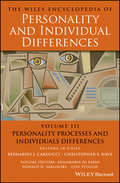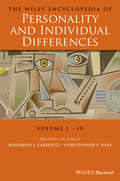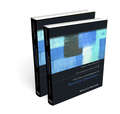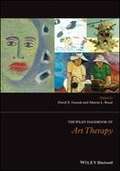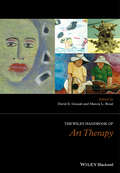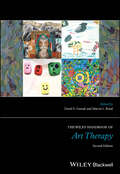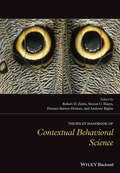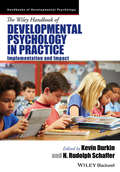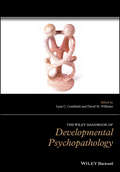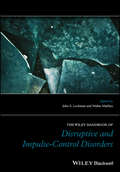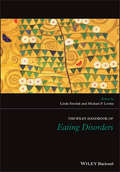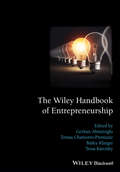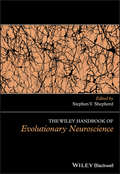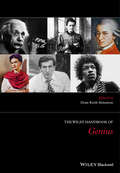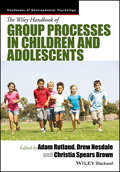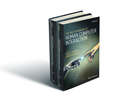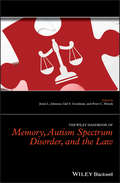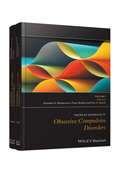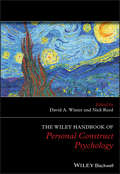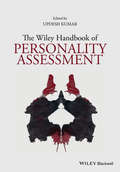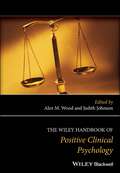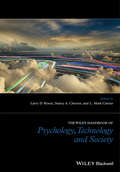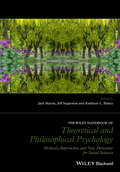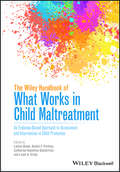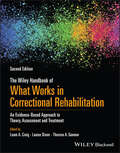- Table View
- List View
The Wiley Encyclopedia of Personality and Individual Differences, Personality Processes and Individuals Differences
by Bernardo J. Carducci Donald H. Saklofske Con Stough Annamaria Di Fabio Christopher S. NaveVolume 3, Personality Processes and Individuals Differences of The Wiley Encyclopedia of Personality and Individual Differences
The Wiley Encyclopedia of Personality and Individual Differences, Set
by Bernardo J. Carducci Donald H. Saklofske Con Stough Ronald E. Riggio Annamaria Di Fabio Christopher S. Nave Jeffrey S. MioThe Encyclopedia of Personality and Individual Differences (EPID) is organized into four volumes that look at the many likenesses and differences between individuals. Each of these four volumes focuses on a major content area in the study of personality psychology and individuals’ differences. The first volume, Models and Theories, surveys the significant classic and contemporary viewpoints, perspectives, models, and theoretical approaches to the study of personality and individuals’ differences (PID). The second volume on Measurement and Assessment examines key classic and modern methods and techniques of assessment in the study of PID. Volume III, titled Personality Processes and Individuals Differences, covers the important traditional and current dimensions, constructs, and traits in the study of PID. The final volume discusses three major categories: clinical contributions, applied research, and cross-cultural considerations, and touches on topics such as culture and identity, multicultural identities, cross-cultural examinations of trait structures and personality processes, and more. Each volume contains approximately 100 entries on personality and individual differences written by a diverse international panel of leading psychologists Covers significant classic and contemporary personality psychology models and theories, measurement and assessment techniques, personality processes and individuals differences, and research Provides a comprehensive and in-depth overview of the field of personality psychology The Encyclopedia of Personality and Individual Differences is an important resource for all psychology students and professionals engaging in the study and research of personality.
The Wiley Handbook of Anxiety Disorders (Wiley Clinical Psychology Handbooks Ser.)
by Paul Emmelkamp Thomas EhringThis state-of-the-art Handbook on the research and treatment of anxiety and related disorders is the most internationally and clinically oriented Handbook currently available, encompassing a broad network of researchers, from leading experts in the field to rising stars. The very first handbook to cover anxiety disorders according to the new DSM-5 criteria Published in two volumes, the International Handbook provides the most wide-ranging treatment of the state-of-the-art research in the anxiety disorders Offers a truly international aspect, including authors from different continents and covering issues of relevance to non-Western countries Includes discussion of the latest treatments, including work on persistence of compulsions, virtual reality exposure therapy, cognitive bias modification, cognitive enhancers, and imagery rescripting Covers treatment failures, transdiagnostic approaches, and includes treatment issues for children as well as the older population Edited by leaders in the field, responsible for some of the most important advances in our understanding and treatment of anxiety disorders 2 Volumes
The Wiley Handbook of Art Therapy
by David Gussak Marcia RosalThe most comprehensive art therapy book in the field, exploring a wide range of themes, A unique collection of the current and innovative clinical, theoretical and research approaches in the field, Cutting-edge in its content, the handbook includes the very latest trends in the subject, and in-depth accounts of the advances in the art therapy arena.
The Wiley Handbook of Art Therapy (Wiley Clinical Psychology Handbooks)
by David E. Gussak Marcia L. RosalThe Wiley Handbook of Art Therapy is a collection of original, internationally diverse essays, that provides unsurpassed breadth and depth of coverage of the subject. The most comprehensive art therapy book in the field, exploring a wide range of themes A unique collection of the current and innovative clinical, theoretical and research approaches in the field Cutting-edge in its content, the handbook includes the very latest trends in the subject, and in-depth accounts of the advances in the art therapy arena Edited by two highly renowned and respected academics in the field, with a stellar list of global contributors, including Judy Rubin, Vija Lusebrink, Selma Ciornai, Maria d' Ella and Jill Westwood Part of the Wiley Handbooks in Clinical Psychology series
The Wiley Handbook of Art Therapy (Wiley Clinical Psychology Handbooks)
by David E. Gussak Marcia L. RosalA comprehensive discussion of the history, theory, and applications of art therapy In the newly revised second edition of the Wiley Handbook of Art Therapy, a team of distinguished art therapists delivers a compilation of unprecedented depth and breadth on the subject of art therapy. It is a contemporary and holistic picture of a profession that has undergone profound transformation since the publication of the first edition of this book. The editors expose you to a wealth of knowledge, wisdom, experiences, and perspectives that explain the countless applications and uses of art therapy. You’ll gain an appreciation for the most recent developments in the field via the contributions of the 116 authors whose works make up this Handbook. Readers will also discover: A thorough introduction to the history of art therapy Comprehensive explorations of the theoretical frameworks on which art therapy is built, including expressive, psychoanalytic, Jungian, and archetypal theories Practical discussions of media considerations in art therapy Complete treatments of developmental milestones, populations, settings, and research models and assessments in art therapy Perfect for practicing art therapists, the Wiley Handbook of Art Therapy will also benefit students in the therapeutic professions and anyone else with an interest in the applications, background, history, and theory of a fascinating and practical discipline.
The Wiley Handbook of Contextual Behavioral Science (Wiley Clinical Psychology Handbooks)
by Dermot Barnes-Holmes Steven C. Hayes Robert D. Zettle Anthony BiglanThe Wiley Handbook of Contextual Behavioral Science describes the philosophical and empirical foundation of the contextual behavioral science movement; it explores the history and goals of CBS, explains its core analytic assumptions, and describes Relational Frame Theory as a research and practice program. This is the first thorough examination of the philosophy, basic science, applied science, and applications of Contextual Behavioral Science Brings together the philosophical and empirical contributions that CBS is making to practical efforts to improve human wellbeing Organized and written in such a way that it can be read in its entirety or on a section-by-section basis, allowing readers to choose how deeply they delve into CBS Extensive coverage of this wide ranging and complex area that encompasses both a rich basic experimental tradition and in-depth clinical application of that experimental knowledge Looks at the development of RFT, and its implications for alleviating human suffering
The Wiley Handbook of Developmental Psychology in Practice: Implementation and Impact (Wiley Blackwell Handbooks of Developmental Psychology)
by Kevin Durkin H. Rudolph SchafferAn authoritative new work exploring the themes of communication and implementation of research within developmental psychology – a scientific field with extensive real world value in addressing problems faced by individuals, families and services Brings together the insights of a stellar group of contributors with personal experience translating developmental psychology research into practice Accessibly structured into sections exploring family processes and child rearing practices; educational aspects; and clinical applications Goes beyond traditional reviews of literature in the field to report on practical implementation of research findings, including the challenges faced by authors Serves as an invaluable resource for developmental psychologists, practitioners working in the field of child development, and policymakers working on issues affecting children and families
The Wiley Handbook of Developmental Psychopathology (Wiley Clinical Psychology Handbooks)
by David M. Williams Luna C. CentifantiThe Wiley Handbook of Developmental Psychopathology offers a concise, up-to-date, and international overview of the study of developmental psychopathology. Examines the cognitive, neurobiological, genetic, and environmental influences on normal and abnormal development across the lifespan Incorporates methodology, theory, and the latest empirical research in a discussion of modern techniques for studying developmental psychopathology Considers the legal, societal, and policy impacts of changes to diagnostic categories in the light of the transition to DSM-5 Moves beyond a disorder-based discussion to address issues that cut across diagnostic categories
The Wiley Handbook of Disruptive and Impulse-Control Disorders
by Walter Matthys John E. LochmanThe definitive reference to the policies and practices for treating disruptive and impulse-control disorders, edited by renowned experts The Wiley Handbook of Disruptive and Impulse-Control Disorders offers a comprehensive overview that integrates the most recent and important scholarship and research on disruptive and impulse-control disorders in children and adolescents. Each of the chapters includes a summary of the most relevant research and knowledge on the topic and identifies the implications of the findings along with important next directions for research. Designed to be practical in application, the text explores the applied real-world value of the accumulated research findings, and the authors include policy implications and recommendations. The Handbook address the nature and definition of the disorders, the risk factors associated with the development and maintenance of this cluster of disorders, assessment processes, as well as the evidence-based treatment and prevention practices. The volume incorporates information from the ICD-11, a newly revised classification system, along with the recently published DSM-5. This important resource: Contains a definitive survey that integrates the most recent and important research and scholarship on disruptive and impulse-control disorders in children and adolescents Emphasizes the applied real-world value of the accumulated research findings Explores the policy implications and recommendations to encourage evidence-based practice Examines the nature and definition, risk factors, assessment, and evidence-based practice; risk factors are subdivided into child, family, peer group and broader context Considers changes, advances and controversies associated with new and revised diagnostic categories Written for clinicians and professionals in the field, The Wiley Handbook of Disruptive and Impulse-Control Disorders offers an up-to-date review of the most authoritative scholarship and research on disruptive and impulse-control disorders in children and adolescents as well as offering recommendations for practice.
The Wiley Handbook of Eating Disorders (Wiley Clinical Psychology Handbooks Ser.)
by Michael P. Levine Linda SmolakThis groundbreaking two-volume handbook provides a comprehensive collection of evidence-based analyses of the causes, treatment, and prevention of eating disorders. A two-volume handbook featuring contributions from an international group of experts, and edited by two of the leading authorities on eating disorders and body image research Presents comprehensive coverage of eating disorders, including their history, etiological factors, diagnosis, assessment, prevention, and treatment Tackles controversies and previously unanswered questions in the field Includes coverage of DSM-5 and suggestions for further research at the end of each chapter 2 Volumes
The Wiley Handbook of Entrepreneurship
by Tomas Chamorro-Premuzic Bailey Klinger Gorkan Ahmetoglu Tessa KarciskyWritten by leading scholars, The Wiley Handbook of Entrepreneurship provides a distinctive overview of methodological, theoretical and paradigm changes in the area of entrepreneurship research. It is divided into four parts covering history and theory, individual differences and creativity, organizational aspects of innovation including intrapreneurship, and macroeconomic aspects such as social entrepreneurship and entrepreneurship in developing countries. The result is a must-have resource for seasoned researchers and newcomers alike, as well as practitioners and advanced students of business, entrepreneurship, and social and organizational psychology.
The Wiley Handbook of Evolutionary Neuroscience
by Stephen V. ShepherdComprehensive and authoritative, The Wiley Handbook of Evolutionary Neuroscience unifies the diverse strands of an interdisciplinary field exploring the evolution of brains and cognition. A comprehensive reference that unifies the diverse interests and approaches associated with the neuroscientific study of brain evolution and the emergence of cognition Tackles some of the biggest questions in neuroscience including what brains are for, what factors constrain their biological development, and how they evolve and interact Provides a broad and balanced view of the subject, reviewing both vertebrate and invertebrate anatomy and emphasizing their shared origins and mechanisms Features contributions from highly respected scholars in their fields
The Wiley Handbook of Genius
by Dean Keith SimontonWith contributions from a multi-disciplinary group of expert contributors, this is the first handbook to discuss all aspects of genius, a topic that endlessly provokes and fascinates. The first handbook to discuss all aspects of genius with contributions from a multi-disciplinary group of experts Covers the origins, characteristics, careers, and consequences of genius with a focus on cognitive science, individual differences, life-span development, and social context Explores individual genius, creators, leaders, and performers as diverse as Queen Elizabeth I, Simón Bolívar, Mohandas Gandhi, Jean-Jacques Rousseau, Leo Tolstoy, John William Coltrane, Georgia O’Keeffe, and Martha Graham. Utilizes a variety of approaches—from genetics, neuroscience, and longitudinal studies to psychometric tests, interviews, and case studies—to provide a comprehensive treatment of the subject
The Wiley Handbook of Group Processes in Children and Adolescents
by Christia Spears Brown Adam Rutland Drew NesdaleA definitive reference on intra- and inter-group processes across a range of age and cultural contexts Children from infancy develop attachments to significant others in their immediate social environment, and over time become aware of other groups (e.g. gender, ethnicity, age, classroom, sports) that they do or do not belong to and why. Recent research shows that children’s attitudes, beliefs and behaviours are significantly influenced by these memberships and that the influence increases through childhood. This Handbook delivers the first comprehensive, international reference on this critical topic.
The Wiley Handbook of Human Computer Interaction Set
by Kent L. Norman Jurek KirakowskiOnce, human-computer interaction was limited to a privileged few. Today, our contact with computing technology is pervasive, ubiquitous, and global. Work and study is computer mediated, domestic and commercial systems are computerized, healthcare is being reinvented, navigation is interactive, and entertainment is computer generated. As technology has grown more powerful, so the field of human-computer interaction has responded with more sophisticated theories and methodologies. Bringing these developments together, The Wiley Handbook of Human-Computer Interaction explores the many and diverse aspects of human-computer interaction while maintaining an overall perspective regarding the value of human experience over technology.
The Wiley Handbook of Memory, Autism Spectrum Disorder, and the Law
by Peter C. Mundy Gail S. Goodman Jonni L. JohnsonAn Important Contribution to Understanding Autobiographical and Eyewitness Memory in Those with ASD and the Unique Legal Challenges They Present This book offers an in-depth discussion of how autobiographical and eyewitness memory operate in individuals with Autism Spectrum Disorder (ASD) and provides unique insights into current challenges faced by legal professionals, forensic psychologists, clinicians, and others who extend services to those with ASD. Throughout the book, authors demonstrate why a nuanced understanding of autobiographical and eyewitness memory is required when assessing individuals with ASD, given the developmental, social, and cognitive deficits at play. Authors review current legal services and structures, and explore ideas on whether and how modifications can be made to meet the needs of all individuals who seek and deserve justice, including individuals with ASD. The Wiley Handbook of Memory, Autism Spectrum Disorder, and the Law is sure to spark debate within the mental health and legal communities, while advancing knowledge on the role of key clinical features of ASD in autobiographical and eyewitness memory. The book is distinct in its exploration of ways in which the legal system, with its formal yet inherently social infrastructure and regulated due process demands, should offer services to those with ASD. Of note, authors question if current policies and practices, such as reliance on interviewing protocols standardized for typically developing individuals, are adequate. The book is divided into three sections with the first providing a discussion of theoretical viewpoints on how memory functions in those with and without ASD, and providing a specialized consideration of developmental issues. A second section reviews empirical evidence, followed by a third and final section addressing legal and clinical considerations, including techniques for interviewing individuals with ASD. The first book offering an expert, science-based review of autobiographical and eyewitness memory research on those with ASD and the associated legal challenges Provides thought-provoking, informative, often debated observations on memory in ASD from an international team of experts Offers summaries of what is known about memory abilities in those with ASD as well as what is left unknown that future researchers will need to address and that legal professionals should consider. A book that does much to advance the research frontier in the study of memory in ASD and application to the legal system, The Wiley Handbook of Memory, Autism Spectrum Disorder, and the Law is important reading for academic researchers, clinicians, judges, jurors, law enforcement officials, and public policy makers alike.
The Wiley Handbook of Obsessive Compulsive Disorders (Wiley Clinical Psychology Handbooks)
by Eric A. Storch Jonathan S. Abramowitz Dean McKayThe Wiley Handbook of Obsessive Compulsive Disorders, 2 volume set, provides a comprehensive reference on the phenomenology, epidemiology, assessment, and treatment of OCD and OCD-related conditions throughout the lifespan and across cultures. Provides the most complete and up-to-date information on the highly diverse spectrum of OCD-related issues experienced by individuals through the lifespan and cross-culturally Covers OCD-related conditions including Tourette’s syndrome, excoriation disorder, trichotillomania, hoarding disorder, body dysmorphic disorder and many others OCD and related conditions present formidable challenges for both research and practice, with few studies having moved beyond the most typical contexts and presentations Includes important material on OCD and related conditions in young people and older adults, and across a range of cultures with diverse social and religious norms
The Wiley Handbook of Personal Construct Psychology
by David A. Winter Nick ReedThe Wiley Handbook of Personal Construct Psychology is the definitive new reference for the field, providing a state-of-the-art review of PCP which focuses on the theory and its philosophy, methodology, areas of application and future horizons A definitive new reference work for the field of personal construct psychology, featuring leading international figures in the field Each section begins with a concise chapter that reviews the literature in the area concerned and highlights new developments Covers theory, history, methodology and a wealth of new and established applications including education, grief and meaning reconstruction, sexuality, organizational consultancy and personal construct coaching Draws on published and previously unpublished work by pioneers including Fay Fransella and Miller Mair
The Wiley Handbook of Personality Assessment
by Updesh KumarThe Wiley Handbook of Personality Assessment presents the state-of-the-art in the field of personality assessment, providing a perspective on emerging trends, and placing these in the context of research advances in the associated fields. Explores emerging trends and perspectives in personality assessment, building on current knowledge and looking ahead to the future landscape of the field Discusses emerging technologies and how these can be combined with psychological theories in order to enhance the real-world practice of assessing personality Comprehensive sections address gaps in current knowledge and collate contributions and advances from diverse areas and perspectives The chapter authors are eminent scholars from across the globe who bring together new research from many different countries and cultures
The Wiley Handbook of Positive Clinical Psychology
by Judith Johnson Alex M. WoodEdited by the founder of the field, this is the first handbook on positive clinical psychology—a revolutionary approach that places equal importance on both the positive and negative aspects of mental health and well-being. The first handbook on positive clinical psychology, a revolutionary approach that places equal importance on the positive and negative aspects of mental health and well-being Brings together new work from authorities in positive psychology and clinical psychology to offer an integrated examination of well-being as it relates to personality, psychopathology, psychological treatments, and more Discusses theory, research, and practice across a broad range of topics such as optimism, positive affect, well-being therapy, childhood well-being, evolutionary perspectives, and clinical implementation Contains essential information for researchers, instructors and practitioners in clinical psychology, positive psychology, mental health, and well-being in general
The Wiley Handbook of Psychology, Technology, and Society
by Larry D. Rosen Nancy A. Cheever L. Mark CarrierEdited by three of the world's leading authorities on the psychology of technology, this new handbook provides a thoughtful and evidence-driven examination of contemporary technology's impact on society and human behavior. Includes contributions from an international array of experts in the field Features comprehensive coverage of hot button issues in the psychology of technology, such as social networking, Internet addiction and dependency, Internet credibility, multitasking, impression management, and audience reactions to media Reaches beyond the more established study of psychology and the Internet, to include varied analysis of a range of technologies, including video games, smart phones, tablet computing, etc. Provides analysis of the latest research on generational differences, Internet literacy, cyberbullying, sexting, Internet and cell phone dependency, and online risky behavior
The Wiley Handbook of Theoretical and Philosophical Psychology
by Jack Martin Kathleen L. Slaney Jeff SugarmanThe Wiley Handbook of Theoretical and Philosophical Psychology presents a comprehensive exploration of the wide range of methodological approaches utilized in the contemporary field of theoretical and philosophical psychology. The Wiley Handbook of Theoretical and Philosophical Psychology presents a comprehensive exploration of the wide range of methodological approaches utilized in the contemporary field of theoretical and philosophical psychology. Gathers together for the first time all the approaches and methods that define scholarly practice in theoretical and philosophical psychology Chapters explore various philosophical and conceptual approaches, historical approaches, narrative approaches to the nature of human conduct, mixed-method studies of psychology and psychological inquiry, and various theoretical bases of contemporary psychotherapeutic practices Features contributions from ten Past Presidents of the Society of Theoretical and Philosophical Psychology, along with several Past Presidents of other relevant societies
The Wiley Handbook of What Works in Child Maltreatment: An Evidence-Based Approach to Assessment and Intervention in Child Protection
by Daniel F. Perkins Leam A. Craig Louise Dixon Catherine Hamilton-GiachritsisA comprehensive guide to empirically supported approaches for child protection cases The Wiley Handbook of What Works in Child Maltreatment offers clinicians, psychologists, psychiatrists and other professionals an evidence-based approach to best professional practice when working in the area of child protection proceedings and the provision of assessment and intervention services in order to maximize the well-being of young people. It brings together a wealth of knowledge from expert researchers and practitioners, who provide a comprehensive overview of contemporary work informing theory, assessment, service provision, rehabilitation and therapeutic interventions for children and families undergoing care proceedings. Coverage includes theoretical perspectives, insights on the prevalence and effects of child neglect and abuse, assessment, children’s services, and interventions with children, victims and families.
The Wiley Handbook of What Works in Correctional Rehabilitation: An Evidence-Based Approach to Theory, Assessment and Treatment
by Leam A. Craig Theresa A. Gannon Louise DixonTheory, assessment, and treatment strategies for offenders across forensic populations, with practical examples and discussion of often overlooked cultural considerations The Wiley Handbook of What Works in the Rehabilitation of People Who Have Offended comprehensively outlines effective rehabilitation strategies for offenders while acknowledging the challenges in implementation and discussing ethical considerations, potential biases, and the need for ongoing evaluation. The book introduces the current state of effective practices, outlines up-to-date risk assessment processes for various crime types, investigates effective treatments for diverse forensic populations, explores treatments for those in prison and mental health settings, and examines the often-overlooked cultural factors influencing rehabilitation efforts. This Second Edition, expanded from 25 to 32 chapters, has been written by leading researchers, seasoned professionals, and academics, providing a wealth of expertise and diverse perspectives. Each chapter offers a well-researched and balanced review of existing literature, laying a solid foundation for comprehending the effectiveness of various rehabilitation approaches. Practical examples enhance the content's applicability, emphasizing evidence-based practices crucial for accountability and effectiveness in the criminal justice system. Some of the sample topics discussed in The Wiley Handbook of What Works in the Rehabilitation of People Who Have Offended include: Risk, Need, and Responsivity principles used in the assessment and triage of offenders and evidence for the Good Lives Model in supporting rehabilitation and desistance from offending Recidivism risk in people convicted of intimate partner violence and treatment of aggressive and problematic adjudicated youth in a secure psychiatric setting Treatment of persons convicted of sexual offenses in the community, including online offending Strategies to prevent and reduce gang involvement and rehabilitation of intellectually disabled individuals who have harmful sexual behavior Offering a valuable evidence-based coverage in the pursuit of effective rehabilitation strategies, the Second Edition of The Wiley Handbook of What Works in the Rehabilitation of People Who Have Offended is an indispensable resource for anyone involved in the criminal justice system, including professionals, policymakers, researchers, and students.
